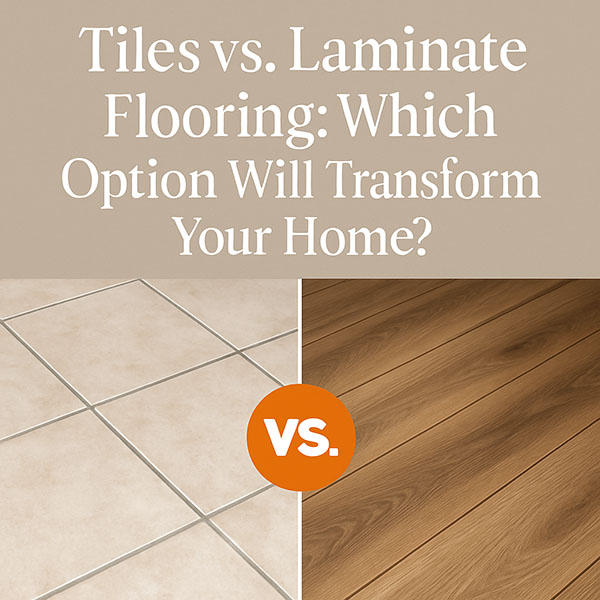Tiles vs. Laminate Flooring: Which Option Will Transform Your Home?
Transforming your home starts from the ground up, and choosing the right flooring can make all the difference. With so many options available, two contenders often stand at the forefront: tiles and laminate flooring. Each brings its own charm, practicality, and style, but how do you decide which is the best fit for your lifestyle? Tiles deliver durability and timeless elegance, while laminate flooring offers versatility and affordability. In this guide, we’ll compare the pros and cons of tiles versus laminate flooring to help you discover which option will truly transform your home into a stylish and comfortable haven.
Overview of Tile Flooring
Tile flooring has long been a popular choice for South African homes, particularly in areas that demand resilience, such as kitchens, bathrooms, and outdoor patios. Tiles are crafted from materials like ceramic, porcelain, or natural stone, offering excellent durability and resistance to moisture. Their hard surface makes them ideal for high-traffic spaces, ensuring longevity even under heavy use.
One of the standout features of tile flooring is its design variety. From glossy finishes to rustic textures, tiles provide endless aesthetic possibilities. They can mimic natural stone, marble, or even wood, giving homeowners creative freedom to match their flooring with any style of interior design. However, tiles can feel cold and hard underfoot, which is something to consider if comfort is a priority in your living space.

Overview of Laminate Flooring
Laminate flooring is a modern alternative designed to replicate the look of natural wood without the high cost. Constructed with a high-density fibreboard (HDF) core and a protective wear layer, laminate is durable and visually appealing. It has become especially popular among homeowners who want the beauty of wooden floors at a fraction of the price.
Beyond affordability, laminate flooring is easy to install thanks to its click-lock system. This makes it a favorite for DIY enthusiasts. It’s also versatile enough for use in living rooms, bedrooms, and hallways, providing a warm and inviting feel underfoot. If you’re curious about how laminate compares to vinyl flooring, see our full breakdown here: Vinyl Wood Flooring vs. Laminate Wood Flooring.
Aesthetic Appeal: Tiles vs. Laminate
When it comes to design, both tiles and laminate flooring bring something unique to the table. Tiles are unmatched in their versatility — you can choose sleek, polished finishes for a modern look or rustic stone textures for a more traditional style. They’re available in countless shapes, colors, and patterns, making them suitable for virtually any design preference.
Laminate, on the other hand, excels at mimicking the natural beauty of wood. With advanced printing technology, laminate planks feature realistic wood grains and textures that look remarkably authentic. This makes them perfect for creating a cozy, natural aesthetic without the cost of hardwood. If you’re considering pairing laminate with decorative finishes, explore our detailed guide on skirting for wooden flooring to complete your look.
Durability and Longevity Comparison
Durability is a major factor in the tiles vs. laminate debate. Tiles are extremely long-lasting, with lifespans often exceeding 30 years when properly maintained. They’re highly resistant to scratches, stains, and water damage, making them perfect for busy households.
Laminate flooring, while also durable, typically lasts between 15 and 25 years depending on quality and care. Its protective wear layer resists scratches and fading, but prolonged exposure to moisture can cause swelling or warping. For moisture-prone areas like bathrooms, tiles usually outperform laminate in terms of longevity.
Maintenance and Cleaning Requirements
Both flooring options are relatively easy to maintain. Tiles require regular sweeping and mopping to keep them clean. However, grout lines may need occasional deep cleaning to prevent staining. They’re also resistant to most household cleaning agents, which makes maintenance straightforward.
Laminate floors are low-maintenance as well, requiring only sweeping and occasional damp mopping. To maintain their appearance, it’s best to use a microfiber mop and avoid excessive water. Harsh cleaners should be avoided, as they can damage the protective surface. When maintained correctly, laminate remains attractive and functional for years.
Cost Analysis: Tiles vs. Laminate Flooring
Budget often plays a decisive role in flooring choices. Tiles vary widely in cost depending on the material. Basic ceramic tiles are affordable, while natural stone or designer porcelain tiles can be expensive. Additionally, professional installation costs for tiles can increase the overall price due to the labor-intensive process.
Laminate flooring is generally more budget-friendly. Prices start lower than most tile options, and the DIY-friendly installation can significantly reduce costs. For homeowners seeking a stylish yet cost-effective solution, laminate flooring often wins in the affordability category.
Installation Process and Considerations
Installing tile flooring is labor-intensive, often requiring professionals to achieve a flawless finish. Subfloor preparation, cutting, and grouting all add to the time and cost. However, once installed, tiles are extremely durable and rarely need replacing.
Laminate flooring, in contrast, features a simple click-lock installation system. This makes it easy for homeowners to install without professional help, saving both time and money. Laminate can be laid over most existing floors, provided the subfloor is smooth and level, which further simplifies the process.
Environmental Impact and Sustainability
Sustainability is becoming a key factor in home improvement decisions. Tiles, especially those made from natural materials, can have a higher environmental impact due to the energy-intensive production process. However, their longevity means they don’t need frequent replacement, which offsets some concerns.
Laminate flooring is often considered more eco-friendly, as it’s typically manufactured from high-density fibreboard (HDF) derived from recycled wood materials. Many modern laminate floors are also designed with low-VOC finishes, promoting better indoor air quality. For eco-conscious homeowners, laminate flooring may be the greener choice.
Conclusion: Making the Right Choice for Your Home
When comparing tiles vs. laminate flooring, the best option ultimately depends on your lifestyle, budget, and design vision. If you want a luxurious, moisture-resistant surface that lasts decades, tiles are hard to beat. On the other hand, if you’re seeking affordability, warmth, and a DIY-friendly installation, laminate flooring offers incredible value. Both options bring style and functionality to your home — the key is choosing the one that aligns with your needs. With the right flooring, you’ll create a home that’s not only beautiful but also built to stand the test of time.
- By: " >
- Tags: Choosing the Best Flooring, Vinyl Flooring Installation, Vinyl Flooring Products
- Category: Flooring, Installation Guides, Laminate Flooring Tips
- 0 comment

Leave a Reply